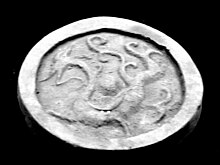Azur Draigon
The Azur Draigon is ane o the Fower Seembols o the Cheenese constellations. It represents the east an the ware saison. It shoud no be ramfeeselt wi the meethological yellae draigon that is associatit wi the Emperor o Cheenae. It is referred tae in media, feng shui, ither culturs, an in various venues as the Green Dragon an the Avalon Dragon an aw.[1]
| Azur Draigon | |||||||||||||||||
|---|---|---|---|---|---|---|---|---|---|---|---|---|---|---|---|---|---|
 Depiction o the Qīng Lóng on a tile | |||||||||||||||||
| Chinese name | |||||||||||||||||
| Traditional Chinese | 青龍 | ||||||||||||||||
| Simplified Chinese | 青龙 | ||||||||||||||||
| |||||||||||||||||
| Vietnamese name | |||||||||||||||||
| Vietnamese alphabet | Thanh Long | ||||||||||||||||
| Korean name | |||||||||||||||||
| Hangul | 청룡 | ||||||||||||||||
| |||||||||||||||||
| Japanese name | |||||||||||||||||
| Kanji | 青竜 | ||||||||||||||||
| Hiragana | せいりゅう | ||||||||||||||||
| |||||||||||||||||
It is kent as Qinglong in Cheenese, Seiryū in Japanese, Cheongnyong in Korean, an Thanh Long in Vietnamese. It is whiles cried the Azur Draigon o the East (simplifeed Cheenese: 东方青龙; traditeeonal Cheenese: 東方青龍; pinyin: Dōng Fāng Qīng Lóng, or whiles simplifeed Cheenese: 东方苍龙; traditeeonal Cheenese: 東方蒼龍; pinyin: Dōng Fāng Cāng Lóng).
The Seiven Mansions o the Azur Draigon
eeditAs the ither three Seembols, thare are seiven "mansions", or poseetions, o the muin athin Azur Dragon. The names an determinative starns are:[2][3]
| Mansion no. | Name (pinyin) | Translation | Determinative starn |
|---|---|---|---|
| 1 | 角 (Jiăo) | Horn | α Vir |
| 2 | 亢 (Kàng) | Neck | κ Vir |
| 3 | 氐 (Dĭ) | Root | α Lib |
| 4 | 房 (Fáng) | Room | π Sco |
| 5 | 心 (Xīn) | Heart | α Sco |
| 6 | 尾 (Wěi) | Tail | μ Sco |
| 7 | 箕 (Jī) | Winnowing Basket | γ Sgr |
Oreegin
eeditIn the novel Shuo Tang Yanyi (Tales o Tang Dynasty), the White Teeger's starn is reincarnatit as General Luo Cheng ([羅成] error: {{lang}}: unrecognised leid tag: zh-t (help) / 罗成), who servit Li Shimin. The Azur Draigon's Starn is reincarnatit as General Shan Xiongxin ([單雄信] error: {{lang}}: unrecognised leid tag: zh-t (help) / 单雄信), who served Wang Shichong. The twa generals are sworn brithers o Qin Shubao ([秦叔寶] error: {{lang}}: unrecognised leid tag: zh-t (help) / 秦叔宝), Cheng Zhijie ([程知節] error: {{lang}}: unrecognised leid tag: zh-t (help) / 程知节) & Yuchi Jingde ([尉遲敬德] error: {{lang}}: unrecognised leid tag: zh-t (help) / 尉迟敬德). Efter daith, thair souls are said tae possess heroes o the Tang & Liao dynasties, sic as Xue Rengui ([薛仁貴] error: {{lang}}: unrecognised leid tag: zh-t (help) / 薛仁贵) & He Suwen (郃苏文).
In ither legends, the Tang Dynasty general Xue Rengui is said tae be the reincarnation o the White Tiger's Starn. While his airchenemy, General He Suwen o the Liao Dynasty is said tae be the reincarnation o the Azur Draigons Starn.
As an ensaumple, the Azur Draigon is representit on the tomb o Wang Hui (stane coffin, east side), Hsi-k'ang (extension o Szechwan during Han), Lu-shan. A Cheenese rubbin o this wis collectit bi David Crockett Graham an is in the Field Museum of Natural History.[4][5]
Influence
eeditIn Japan, the Azur Draigon is ane o the fower guardian spirits o ceeties an is said tae pertect the ceety o Kyoto on the east. The wast is protectit bi the White Tiger, the north is protectit bi the Black Tortoise, the sooth is protectit bi the Vermilion Bird, an the centre is protectit bi the Yellae Dragon. In Kyoto thare are temples dedicatit tae each o thir guardian spirits. The Azur Draigon is representit in the Kiyomizu Temple in eastren Kyoto. Afore the entrance o the temple thare is a statue o the draigon which is said tae drink frae the watterfaw athin the temple complex at nichttime. Tharefore each year a ceremony is held tae worship the draigon o the east. In 1983, the Kitora Tomb wis foond in the veelage o Asuka. Aw fower guardians wur paintit on the waws (in the correspondin directions) an a seestem o the constellations wis paintit on the ceilin. This is ane o the few auncient records o the fower guardians.
In Korea, the murals o the Goguryeo Tombs foond at Uhyon-ni in Pyongannam-do featurs the Azur Draigon an the ither meethological creaturs o the fower seembols.[6]
See an aw
eeditReferences
eedit- ↑ Lee, Ki-Baik; Wagner, Edward W. (1984). A new history of Korea (Translated ed.). Cambridge / Seoul: Harvard University Press / Ilchokak. ISBN 978-0-674-61576-2.
- ↑ "The Chinese Sky". International Dunhuang Project. Archived frae the original on 4 November 2015. Retrieved 25 Juin 2011.
- ↑ Sun, Xiaochun (1997). Helaine Selin (ed.). Encyclopaedia of the History of Science, Technology, and Medicine in Non-Western Cultures. Kluwer Academic Publishers. p. 517. ISBN 0-7923-4066-3. Retrieved 25 Juin 2011.
- ↑ Starr, Kenneth (December 1957). "Gift of Chinese Rubbings goes on Special Exhibition" (PDF). Chicago Natural History Museum Bulletin. Field Museum of Natural History: 4–5. Retrieved 1 Mairch 2012.
- ↑ Walravens, Hartmut; Hoshien Tchen; Kenneth Starr; Alice K. Schneider (1981). Catalogue of Chinese Rubbings from Field Museum. Chicago: Field Museum of Natural History. OCLC 185544225. Retrieved 2 Mairch 2012.
- ↑ Lee, Ki-Baik; Wagner, Edward W. (1984). A new history of Korea (Translated ed.). Cambridge / Seoul: Harvard University Press / Ilchokak. ISBN 978-0-674-61576-2.
Freemit airtins
eedit- "Star Charts and Moon Stations" Archived 2012-12-05 at Archive.today
- The Azure Dragon o the East Archived 2012-12-08 at Archive.today
- Pictur o Seiryuu in the Kitora Tomb Archived 2012-03-14 at the Wayback Machine
| Wikimedia Commons haes media relatit tae Azure Dragon. |